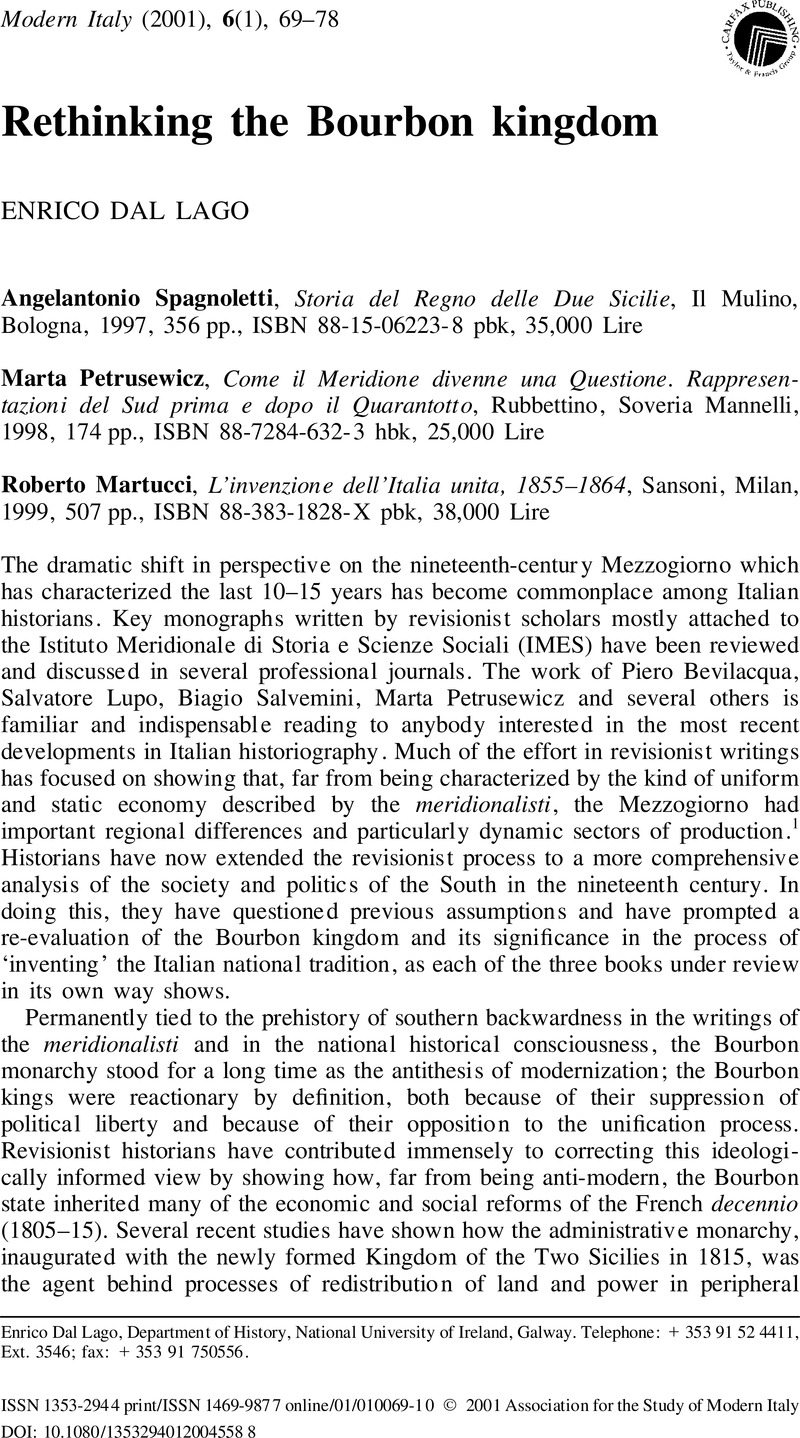Article contents
Rethinking the Bourbon kingdom
Published online by Cambridge University Press: 18 May 2016
Abstract

- Type
- Review Articles
- Information
- Copyright
- Copyright © Association for the study of Modern Italy
References
Notes
1. For recent assessments of revisionist historiography of the Mezzogiorno, see Morris, J., ‘Challenging Meridionalismo. Constructing a new history of Southern Italy’, in Lumley, R. and Morris, J. (eds), The New History of the Italian South: The Mezzogiorno Revisited, Exeter University Press, Exeter, 1997, pp. 1–19; Davis, J. A., ‘Casting off the “Southern Problem”, or the peculiarities of the South reconsidered’, in Schneider, J. (ed.), Italy's ‘Southern Question’: Orientalism in One Country, Berg, New York, 1998, pp. 205–24; and Riall, L., ‘Which road to the South? Revisionists revisit the Mezzogiorno’, Journal of Modern Italian Studies, 5, 1, 2000, pp. 89–100.Google Scholar
2. An assessment of the shift in perspective operated by the new historiography on the Bourbons and the Kingdom of the Two Sicilies is in Mieli, P., ‘La Sinistra riscopre i Borbone’, La Stampa, 16 November 1997. Key works which have shed light on the Bourbon administrative monarchy and its ties to the French decennio include, among others, Massafra, A. (ed.), Il Mezzogiorno preunitario. Economia, società, istituzioni, Dedalo, Bari, 1988; Civile, G., Il comune rustico. Storia sociale di un paese del Mezzogiorno nell'Ottocento, Il Mulino, Bologna, 1990; Pezzino, P., Il Paradiso abitato dai diavoli. Società, elites, istituzioni nel Mezzogiorno contemporaneo, FrancoAngeli, Milan, 1992; Di Ciommo, E., La nazione possibile. Mezzogiorno e questione nazionale nel 1848, FrancoAngeli, Milan, 1993; Benigno, F. and Torrisi, C. (eds), Elites e potere in Sicilia dal Medioevo a oggi, Meridiana Libri, Catanzaro, 1995; Iachello, E. (ed.), I Borbone in Sicilia (1734–1860), Maimone, Catania, 1998; Signorelli, A., Tra ceto e censo. Studi sulle elites urbane nella Sicilia dell'Ottocento, FrancoAngeli, Milan, 1999.Google Scholar
3. Lepre, A., Storia del Mezzogiorno d'Italia, II: Dall'antico regime alla società borghese (1657–1860), Liguori, Naples, 1986.Google Scholar
4. Acton, H., The Bourbons of Naples (1734–1825), Methuen, London, 1957 and The Last Bourbons of Naples (1825–1860), Methuen, London, 1960. Demarco, D., Il crollo del Regno delle Due Sicilie, vol. I: La struttura sociale, Università degli Studi di Napoli, Naples, 1960.Google Scholar
5. Petrusewicz, M., Latifundium: Moral Economy and Material Life in a European Periphery, University of Michigan Press, Ann Arbor, 1996.Google Scholar
6. Interview with Marta Petrusewicz by Ocone, Corrado in Ocone, C., ‘La rivoluzione fallita del 1848 creò il mito del Sud arretrato’, L'Unità, 30 August 1997.Google Scholar
7. See especially Bevilacqua, P., ‘New and old in the Southern Question’, Modern Italy 1, 2, 1996, pp. 81–92; and Bevilacqua, P., ‘Introduzione’, in his Breve storia dell'Italia meridionale dall'Ottocento a oggi (2nd edn) Donzelli, Rome, 1997, pp. vii–xvii Google Scholar
8. Di Ciommo, , La nazione possibile.Google Scholar
9. Coppini, P., ‘Il Piemonte sabaudo e l'unificazione (1849–1861)’ in Sabbatucci, G. and Vidotto, V. (eds), Storia d'Italia, I, Le premesse dell'Unità, Laterza, Rome–Bari, 1994. Riall, L., ‘Garibaldi and the South’, in Davis, J. A. (ed.), Italy in the Nineteenth Century, Oxford University Press, Oxford, 2000, pp. 132–53. Candeloro, G., Storia dell'Italia moderna, IV: Dalla rivoluzione nazionale all'unità, 1849–1860, Feltrinelli, Milan, 1964. Scirocco, A., Il Mezzogiorno nella crisi dell'unificazione (1860–1861), Società Editrice Napoletana, Naples, 1981.Google Scholar
10. Riall, L., Sicily and the Unification of Italy: Liberal Policy and Local Power, 1859–1866, Clarendon Press, Oxford, 1998.Google Scholar
11. See Omodeo, A., L'opera politica del conte di Cavour (1848–1857), 2 vols, La Nuova Italia, Florence, 1941; and Romeo, R., Cavour e il suo tempo, 3 vols, Laterza, Rome–Bari, 1977–84.Google Scholar
12. Pieri, P., Storia militare del Risorgimento. Guerre e insurrezioni, Einaudi, Turin, 1962.Google Scholar
13. See Mack Smith, D., Cavour and Garibaldi. A Study in Political Conflict (2nd edn) Cambridge University Press, Cambridge, 1985.Google Scholar
14. Quotation in Mieli, P., ‘I Mille di Franceschiello’, La Stampa, 9 July 2000. See also Jaeger, P. G., Francesco Il di Borbone, l'ultimo re di Napoli, Mondadori, Milan, 1982.Google Scholar
15. See also Izzo, F., I lager dei Savoia. Storia infame del Risorgimento nei campi di concentramento meridionali, Edizioni Controcorrente, Naples, 1999.Google Scholar
- 1
- Cited by




